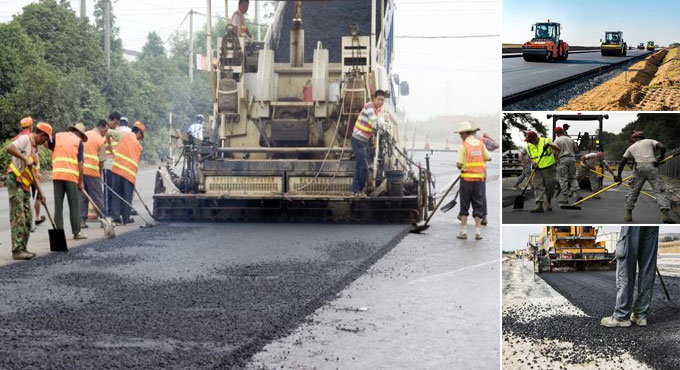
Common types of road construction
The natural earth track does not have the capacity to resist modern heavy traffic loads properly due to fewer strength and good riding surface. So, it is necessary to build up some structure in the form of pavements on the top of natural surface to facilitate it to support wheel load safety and to arrange a good riding surface for a prolonged time.
Therefore, the roads should be built up and maintained in proper manner to minimize the deterioration of vehicles and raise the speed of transportation. Therefore, the proper methods of construction should be followed for the roads as per specification.
Construction of Earth Roads:
Initially all sub-grades arranged and all the road surfaces are driven to necessary camber and gradient. Then the surface is rolled perfectly and drenched with water. Then graded soil with 10 cm thick dense layer is distributed uniformly.
This layer of soil is rolled at greater moisture content first with appropriate roller and then completed with light roller. In case of placing a secondary roller, the process should be similar as the first layer and rolled perfectly. At the end finished surface is soaked for about 5 days for curing and traffic is restricted in these days.
Construction of Bituminous Roads - The following types of bituminous roads are normally found:
Surface painting road: Surface painting or surface dressing bituminous roads are suitable for small traffic.
To develop these types of roads, initially water bound macadam road should be built up. The surface is cleansed with wire brushes and brooms to produce grooves in the joints of the surface. Then a layer of hot charcoal or asphalt is sprayed over the surface. Over this layer, a layer of stone chippings is placed and rolled perfectly.
It arranges the aggregate into the binder. The thickness of this layer remains among 2 to 3 cm. This surface dressing provides a thin, water resistant and dustless surface of the road. Approximately, 2 kg of binder per sq.m. area of road surface is applied and 1.8 to 2 cm of stone chipping are necessary per 100 sq.m. of the surface.
For heavy traffic two layers or dressing should be arranged to the road surface. In second coat 1.5 kg of bitumen or tar should be arranged each sq meter of road surface.
Bituminous Macadam road: Under this type of road construction, the aggregates are distributed in the prepared base. It is then rolled with roller and then the bituminous binder is sprinkled on the surface that is infiltred to full or part depth of the compacted aggregate and thus attaches them together.
Bituminous Concrete roads: These types of roads are suitable for heavy and mixed traffic. The base of this road is also water bound macadam.
Initially, the surface of water bound macadam is cleansed with wire brushes. Side Krebs of soil is produced to support the bituminous surfacing.
The road metal containing size of 6.3 mm is heated to a temperature of 180?. Then coarse sand of 1.3 mm size is also blended in the road metal in the ratio of 1:2. Then bitumen or tar is heated at similar temperature since road metal is mixed with road metal in a mixing plant. This hot mixture is circulated on the cleaned surface of water bound macadam uniformly and perfectly among the Kerbs in a thickness of 5 to 10 cm. This surface is then rolled with roller to exact camber and grade. Over this a sealing coat of coarse sand and bitumen is provided on this surface and surface is again rolled. This type of road surface comes with a smooth surface and pleasant looking finish.
Sheet Asphalt road: Sheet asphalt creates a standard type of surface. This type of road surface is suitable for water bound macadam base or concrete base. It comprises of 60 mm thick layer of asphaltic concrete over which 20 to 40 mm thick carpet of sand-bitumen-mix is placed.
To get more details about other types of roads, click on the following link thepassionateseeker.com


